New York Rangers goalies revisited: So close

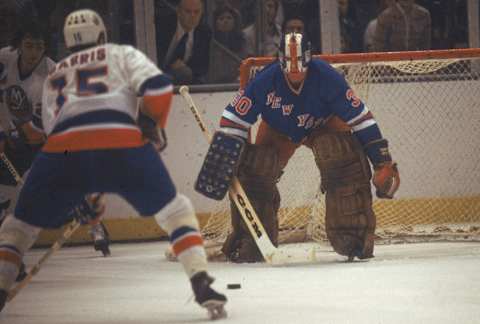
Many Rangers goalies gave the team everything they had, but most went their entire New York careers without ever bringing a Stanley Cup to Madison Square Garden.
In our last story we looked at Rangers goalies of the past who won the Stanley Cup or made it to the Finals, just not in New York. There is no greater glory than winning a Cup with the Rangers, it is sports immortality, and no bigger disappointment than almost making it to the mountain top but ultimately coming up empty.
Six Blueshirts goaltenders have known that agony.
John Ross Roach
John Ross Roach deserves to be recognized, if for no other reason than his impressive collection of nicknames: Little Napoleon, The House Cleaner, The Port Perry Cucumber, and/or The Port Perry Woodpecker.
Only 5’5″ and a buck-thirty, Roach is among the NHL’s tiniest goalies ever. But that’s not all he was known for. He is one of only six people to mind the net while captaining his team, the 1924-25 Toronto St. Patricks. In 1922, he led Toronto past the heavily-favored, defending champion Ottawa Senators, then beat the Pacific Coast Hockey Association’s Vancouver Millionaires (a team name decades ahead of its time) for Toronto’s only Stanley Cup as the St. Pats.
There was also a franchise in the PCHA called the Victoria Aristocrats. Obviously, team names in the Roarin’ Twenties said more about the owners than players or fans.
In 1928, Toronto (now the Maple Leafs) traded Roach to New York for Lorne Chabot (more about him tomorrow), in an exchange of netminders. That season, Roach set Rangers’ team records for shutouts (13) and Goals Against Average (1.41), marks that still stand nearly a century later, taking them to the Stanley Cup Finals.
In the first battle of two American-based teams for the Cup, the Rangers lost to the Boston Bruins and their star goalie, “Tiny” Thompson, though it’s worth noting that Tiny was actually five inches taller than John Ross Roach.
It was a close series, at least, which couldn’t be said when the Rangers returned to the Cup Finals in 1932 . Game Two of that best of five series had to be played in Boston because the circus had taken over the Garden. Roach allowed 6 goals in all three games and his old team won their first Stanley Cup as the Maple Leafs.
Maybe because of that disappointment, Roach was sold to Detroit after the season ended. He then had a great year, but fell just…uh…short of winning the Vezina Trophy, losing to nemesis Tiny Thompson. Roach is left with the destinction of being the only New York Rangers netminder to lose two Stanley Cup Finals.
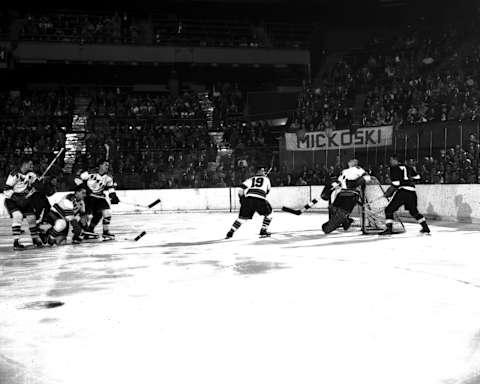
Chuck Rayner
Chuck Rayner played nine seasons in the NHL, a career interrupted by three years of service in the Royal Canadian Navy. He turned pro in 1940, joining the New York Americans, fellow tenants of Madison Square Garden who were founded one year before the team we know and love.
MSG management also owned the Rangers and they forced the Americans out of Manhattan in 1941. After a year spent mostly in the AHL, Rayner became the leading goalie for the Amerks’ final season in Brooklyn. Their demise is the reason nobody refers to an “Original Seven”.
After his stint in the navy, the man known as “Bonnie Prince Charlie” signed with the Rangers in 1945. Chuck Rayner was a mainstay in goal for the next seven seasons, playing well for bad teams. He never had a winning regular season record in the NHL, even in 1949-50, when he won the Hart Trophy as the league’s most valuable player. That year, the Rangers made the Stanley Cup Finals, going up against the Boston Bruins.
They won two games in overtime, taking Boston to a Game Seven, but lost in double OT. This was the last Stanley Cup Final where one team did not host a game as the circus had once again taken over Madison Square Garden, forcing New York to play their ‘home’ games at a neutral site in Toronto.
Injured in 1953, Rayner lost his starting job to Gump Worsley. He knocked around in the minors before finally retiring. In 1973, Chuck Rayner was elected to the Hall of Fame, one of only a handful of goalies enshrined with a losing record.
Fun fact:
As of 2019, there were 284 players (including six women) elected to the Hockey Hall of Fame. And only 36 goaltenders.
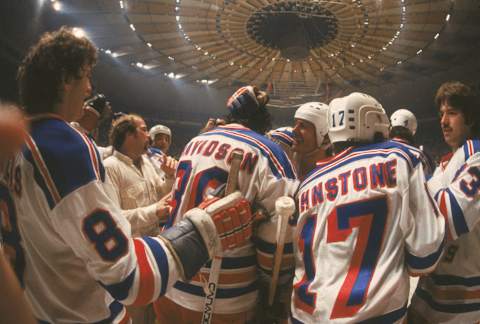
John Davidson
John Davidson has been a fixture in the NHL for almost 50 years, as a player, announcer, and executive. He was drafted fifth overall in 1973 by the Blues. After two seasons in St. Louis, he joined the Rangers in 1975. His career in net wasn’t exactly stellar, but a highlight was taking the Rangers to the Stanley Cup Finals in 1979 while nursing a knee injury that would eventually need surgery to correct.
Led by Phil Esposito and Carol Vadnais (acquired from Boston in exchange for Rangers legends Brad Park and Jean Ratelle), New York won the first game and had a 2-0 lead in the second contest. It was all downhill from there, as Montreal took the Cup in five games. 1979 was the last meeting of Original Six teams in the Finals for 34 years.
Never able to keep free of injuries, Davidson retired in 1983 and entered the broadcast booth.
The St. Louis Blues named him team president in 2006. Six years later, he took the same position with the Columbus Blue Jackets. In May 2019, J.D. was named president of the New York Rangers, tabbed to lead the team through their post-Letter rebuilding phase.
John Davidson trivia:
Davidson and Martin Biron are the only two players in NHL history to wear the jersey number 00.
Davidson inspired a hit song. In the 1977 season, he suffered a concussion and was taken off the ice. Two members of the band Foreigner were watching the game and heard the announcers say the goalie would not return and was suffering from “double vision”. And the rest is rock history.
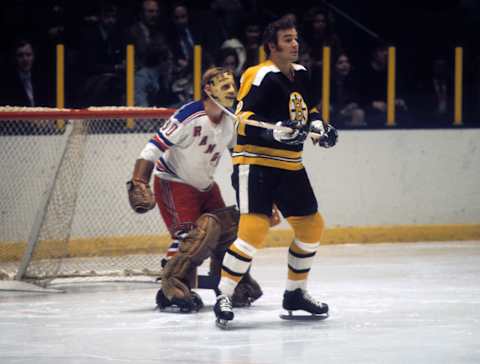
Gilles Villemure
After being stuck in the minor leagues for a decade, Gilles Villemure had a short, but brilliant career in net for the Rangers. Starting in 1970, Villemure posted three consecutive 20-win seasons as a backup for New York, with 10 shutouts and GAA’s of 2.30, 2.09, and 2.29. He played in the All-Star Game those same years, only giving up a single goal, and shared the 1971 Vezina Trophy with fellow Ranger Eddie Giacomin.
Villemure started three games of the 1972 Finals against Boston, winning one, with the Bruins taking the series 4-2.
Traded to Chicago in 1974, Villemure backed up Tony Esposito, only playing in a handful of games, before retiring in 1977.

Eddie Giacomin
When Eddie Giacomin started playing professional hockey, there were only six teams in the NHL, just six starting goalie slots in the entire league. It took five years of playing in the minors, but Giacomin eventually attracted the attention of the Rangers and Red Wings. New York sent four players (including their starting goalie) to the AHL’s Providence Reds to acquire him.
Giacomin minded the Rangers’ net through the late Sixties and early Seventies, the heart of New York’s years of Cup futility, but he racked up 38 shutouts in five years starting in 1966.
1971 saw Eddie win 27 games, with a 2.16 GAA, and he was awarded the Vezina Trophy, along with teammate Gilles Villemure. Giacomin won a playoff game against the Blackhawks, staying in net even after Bobby Hull’s skate sliced his hand open.
The closest he came to winning a championship was 1972, when the Rangers took Boston to six games in the Finals but fell just short.
In 1976, the Rangers started a purge of higher-priced veterans and waived Giacomin, who was snatched up by the Red Wings. Maybe a coincidence, maybe fate, Detroit’s next game was in Madison Square Garden. That night, New York fans did not hesitate to express their feelings, booing their own team.
The video is awful, but the audio comes through loud and clear, especially at the 1:30 mark):
The Red Wings (and Eddie Giacomin) won that game.
Giacomin retired in 1978 with a record of 289-208-97 and a 2.82 GAA. He was inducted into the Hockey Hall of Fame in 1987. After Rod Gilbert, Giacomin’s jersey number 1 was the second ever retired by the Rangers.
Current Rangers’ management might want to remember that those who do not remember the past are condemned to repeat it, and be careful how they treat (and dispose of) one of their most beloved players.
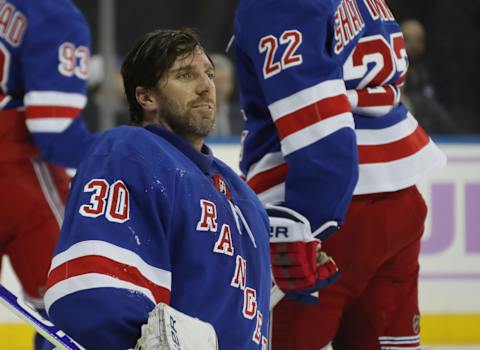
Henrik Lundqvist
There’s not much to be told about Henrik Lundqvist that New York fans don’t already know. Before and since joining the Rangers in 2005, King Henry has racked up an impressive list of achievments in goal.
Gold medal winner with Sweden in the 2006 Olympics.
Most wins by a Rangers rookie, with 30.
Nominated for the Vezina Trophy his first three NHL seasons, before winning it in 2012.
First goalie to start his career with eleven straight 20-win seasons.
Only goalie to ever have 20 wins in 13 consecutive seasons.
Eleven 30-win seasons in the first twelve years of his career.
Named the Rangers Most Valuable Player five consecutive seasons.
Most wins and shutouts in a career by a Rangers goalie.
Five straight Game Seve victories.
But no Stanley Cup.
He threw a 1-0 shutout against the Montreal Canadiens in Game 6 of their 2014 Conference series. That led to a Rangers showdown with Los Angeles for the Finals, but New York fell, 4 games to 1, losing in double overtime of Game Five.
Lundqvist started all 19 of the Rangers playoff games in 2015, with a 2.11 GAA and .928 save percentage, but New York couldn’t score enough to escape the Eastern Conference Finals, losing in seven games to Tampa Bay.
Though the 2019-20 season wasn’t his best for a variety of reasons, as of the suspension of play, Henrik Lundqvist has a record of 459-310-96, with 64 shutouts and no ties. He has a career GAA of 2.43, a .918 Save Pct., and the sixth most wins by a goalie all-time.
His future (as is that of the entire NHL) is up in the air right now. Will he stick around (in New York or elsewhere) in hopes of adding a Cup, the only thing he lacks, to his resume? Either way, the Hall of Fame awaits King Henry after the end of his playing days.
Tomorrow:
We continue our look at Ranger goaltenders. This time it’s the winners.
Even though they are an Original Six team, the Rangers have only won four Stanley Cups in nearly 100 years. Every fan should know
was the hero of the 1993-94 season, but how many of the other championship goalies can you name?
Related Story. Cup success but not in NY. light